Skip to comments.
‘Tis the Season to Spot Jupiter: A Guide to the 2014 Opposition
universetoday.com ^
| December 23, 2013
| David Dickinson on
Posted on 12/23/2013 9:47:23 AM PST by BenLurkin
Orbiting the Sun once every 11.9 years, oppositions of Jupiter occur about once every 13 months or about 400 days, as the speedy Earth overtakes the gas giant on the inside track. This means that successive oppositions of the planet move roughly one astronomical constellation eastward. In fact, this year’s opposition is it’s northernmost in 12 years, occurring in the constellation Gemini. “Opposition” means that an outer planet is rising “opposite” to the setting Sun. As this opposition of Jupiter occurs just weeks after the southward solstice, Jupiter now lies in the direction that the Sun will occupy six months from now during the June Solstice.
This all means that Jupiter will ride high in the sky for northern hemisphere observers towards local midnight, a boon for astrophotographers looking to catch the planet high in the sky and out of the low horizon murk.
(Excerpt) Read more at universetoday.com ...
TOPICS: Astronomy; Science
KEYWORDS: astronomy; gemini; jupiter; science
Navigation: use the links below to view more comments.
first previous 1-20, 21-35 last
To: BenLurkin
21
posted on
12/23/2013 11:06:26 AM PST
by
zeebee
(There are no coincidences.)
To: mikrofon; SunkenCiv
Yes...she did make it her life’s task to give him grief!
22
posted on
12/23/2013 11:13:41 AM PST
by
BenLurkin
(This is not a statement of fact. It is either opinion or satire; or both.)
To: ETL
23
posted on
12/23/2013 11:20:02 AM PST
by
BenLurkin
(This is not a statement of fact. It is either opinion or satire; or both.)
To: zeebee
Photos have been taken through telescopes only because the astronomers know exactly where the craft will be and when. I don't believe it can be tracked without a lot of specially programmed computers. Amateurs track them by manually moving the scope. I don't know if it can be done with a scope other than one with a Dobsonian mount. Dob-mounted scopes move freely in any direction.
24
posted on
12/23/2013 11:33:35 AM PST
by
ETL
(ALL (most?) of the Obama-commie connections at my FR Home page: http://www.freerepublic.com/~etl/)
To: All
A Beginner’s Guide to Photographing The International Space Station (ISS)
by VirtualAstro on February 20, 2012
Want to stay on top of all the space news? Follow @universetoday on Twitter
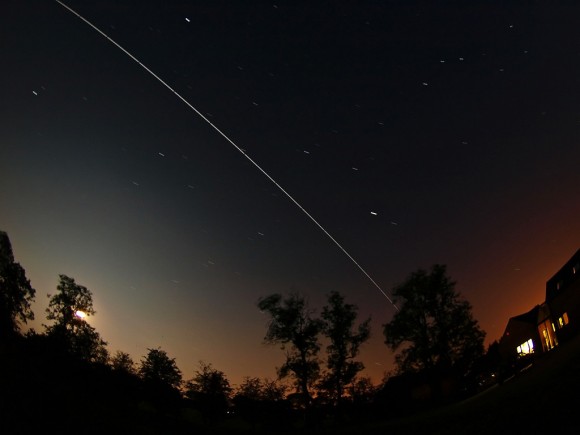
Long Exposure Photograph of the ISS Credit: Mark Humpage
If you have seen the International Space Station (ISS) pass over a few times with your own eyes, (
here’s our guide on seeing it) you may want to have a go at photographing it.
Photographing the ISS is very worthwhile and gratifying. There are two basic methods; one being easy and the other being a little more difficult. Both methods are incredibly rewarding and good results can be obtained fairly quickly, once you have mastered the basics.
Method 1:
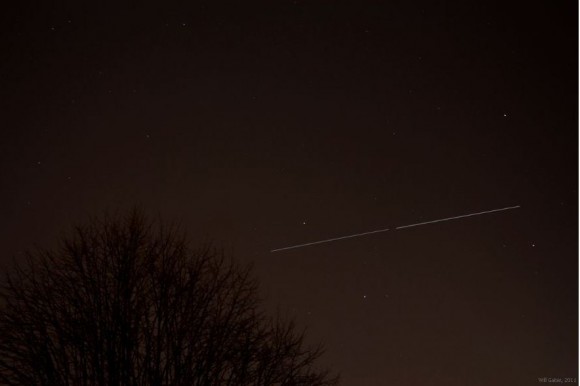
Discovery and ISS pass over the UK on March 7, 2011, captured by Will Gater.
You will need a DSLR camera or another type of camera which is capable taking long exposures. Incredibly important is having a tripod or somewhere you can place your camera without it getting vibrations or movement.
Find out when and where the ISS will be passing over your location and choose a part of the sky the ISS is passing through at which you can point your camera.
Experiment with your camera settings, to get colours and exposures correct beforehand and do a couple of long exposure test shots of anything from 15 to 60 seconds. You can do shorter or longer exposures but this is up to you, depending your equipment and how artistic you want to be.
This method will produce a long white streak or line, which will show the path taken of the International Space Station as it passes over. This is the most common method for amateurs.
Method 2:
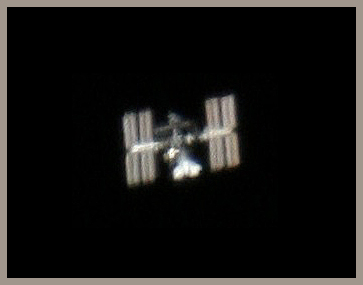
The ISS and shuttle Discovery during the STS-131 mission. Credit: Ted Judah
You will need a telescope, a webcam, and a strong mount or tripod. Set up your telescope and mount, along with webcam with a laptop and make sure of the time and where the ISS will be passing over your location.
In this method we will use the telescope to magnify and see the ISS up close while recording a movie (AVI). We will then stack the frames of the recorded movie in a specialist image enhancing program such as Registax.
Insert your WebCam into the telescope focusing tube using an adapter (available from astronomy stores) and connect the cables to your laptop. When the ISS is due, start recording and track the space station using a finder scope or computerized mount.
The difficult part of this method is tracking the ISS and keeping it in the field of view of the telescope while recording the video file. It is recommended that you set your mount in “Alt/ Az” mode or use a Dobsonian telescope so that you have free movement of telescopes optical tube assembly. You will basically be using the telescope as a giant video camera and you need to keep the ISS in shot for as long as possible.
This method is very difficult as the ISS has been magnified highly while moving very quickly and can be easily lost out of the field of view, or there can be too much movement (shaking) in the video. This method requires much practice.
Once you have been able to get a video of the ISS passing over, you can feed your video file into software such as RegiStax and the program will sort each individual frame, removing bad frames and stacking good frames to create a very clear image.
This method is fantastic for creating close up images with detail on the International Space Station; you can also see docked spacecraft. You can also use this method for trying to image other Earth-orbiting satellites, too.
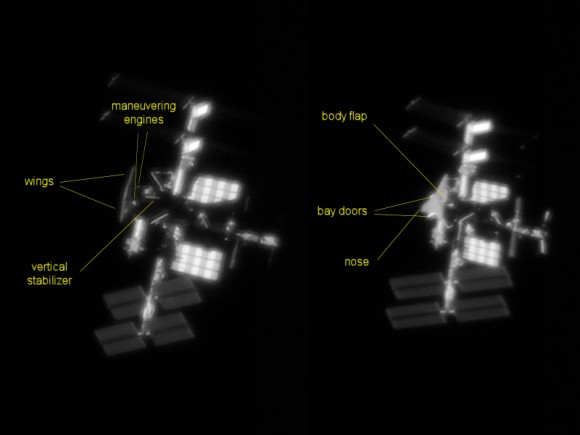
The ISS and shuttle Discovery as captured -- and annotated -- by Thierry Legault
It would be great to see your ISS photographs, so please send them into us via our Flickr site. Good luck!
http://www.universetoday.com/93588/a-beginners-guide-to-photographing-the-international-space-station-iss/
25
posted on
12/23/2013 11:38:23 AM PST
by
ETL
(ALL (most?) of the Obama-commie connections at my FR Home page: http://www.freerepublic.com/~etl/)
To: All
"This video shows you how to photograph the international space station using a non-computerized, non-tracking, telescope. I am using a 12-inch Dobsonian telescope, but a slightly smaller telescope would work just as well."
http://www.youtube.com/watch?v=7eF7LQl0f0c
26
posted on
12/23/2013 11:43:19 AM PST
by
ETL
(ALL (most?) of the Obama-commie connections at my FR Home page: http://www.freerepublic.com/~etl/)
To: zeebee
Here is a page that shows the positions of the largest 4 moons of Jupiter at any time. It’s very cool to watch through a telescope since the moons travel so fast you can often see them orbiting if one passes another or occults or eclipses.You never actually 'see' them moving. It can take many minutes to detect the slightest change in position.
27
posted on
12/23/2013 11:54:16 AM PST
by
ETL
(ALL (most?) of the Obama-commie connections at my FR Home page: http://www.freerepublic.com/~etl/)
To: BenLurkin
I’d like to check it out some night but here in Michigan, the rain and snow clouds don’t go away until spring.....sometimes later.
28
posted on
12/23/2013 12:10:02 PM PST
by
Hot Tabasco
(Miss Muffit suffered from arachnophobia.....)
To: BenLurkin; SunkenCiv
True, but compared to Jove's splendor, she's not much to look at these days ....
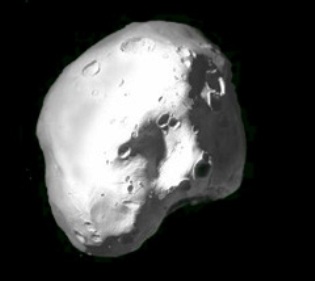
29
posted on
12/23/2013 12:29:57 PM PST
by
mikrofon
(Ceres-ly)
To: ETL
Au contraire, you can see them moving.
When one is in front moving to the east and another is behind moving to the west and they cross, you can easily watch the distance change.
Some of the moons orbit in less than 2 days (unlike ours which takes a month).
30
posted on
12/23/2013 1:27:35 PM PST
by
zeebee
(There are no coincidences.)
To: zeebee
Perhaps you can in those special circumstances, but they don’t come around too often, comparatively speaking.
31
posted on
12/23/2013 1:33:18 PM PST
by
ETL
(ALL (most?) of the Obama-commie connections at my FR Home page: http://www.freerepublic.com/~etl/)
To: zeebee
...and I would imagine that would likely involve very high magnification and a very good scope.
32
posted on
12/23/2013 1:35:22 PM PST
by
ETL
(ALL (most?) of the Obama-commie connections at my FR Home page: http://www.freerepublic.com/~etl/)
To: ETL
75X magnification is all you need to see the bands across the disk and even the shadows of the moons as they transit the planet. But yes, you need a scope with decent optics. I use this:
http://www.netaxs.com/~mhmyers/camera.html#FS
33
posted on
12/23/2013 4:46:12 PM PST
by
zeebee
(There are no coincidences.)
To: zeebee
Thanks, but I meant to actually see the moons moving before your eyes it would probably take very high magnification and a very good scope.
I’ll check out the link in a little while.
34
posted on
12/23/2013 4:50:06 PM PST
by
ETL
(ALL (most?) of the Obama-commie connections at my FR Home page: http://www.freerepublic.com/~etl/)
To: BenLurkin; mikrofon; brytlea; cripplecreek; decimon; bigheadfred; KoRn; Grammy; married21; ...
Thanks BenLurkin and mikrofon, extra to APoD.
35
posted on
12/23/2013 5:01:04 PM PST
by
SunkenCiv
(http://www.freerepublic.com/~mestamachine/)
Navigation: use the links below to view more comments.
first previous 1-20, 21-35 last
Disclaimer:
Opinions posted on Free Republic are those of the individual
posters and do not necessarily represent the opinion of Free Republic or its
management. All materials posted herein are protected by copyright law and the
exemption for fair use of copyrighted works.
FreeRepublic.com is powered by software copyright 2000-2008 John Robinson




